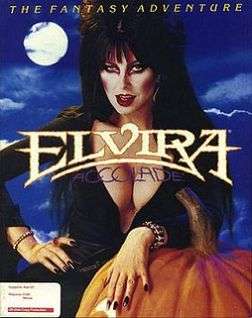Elvira: Mistress of the Dark
|
Cover art for the Atari ST | |
| Developer(s) | Horror Soft |
|---|---|
| Publisher(s) | Accolade |
| Designer(s) |
Alan Bridgman Keith Wadhamsa Michael and Simon Woodroffe |
| Artist(s) |
Paul Drummond Michael Landreth Philip Nixon |
| Composer(s) | Dave Hasler |
| Engine | AberMUD (modified) |
| Platform(s) | Amiga, Atari ST, Commodore 64, MS-DOS |
| Release date(s) | 1990 |
| Genre(s) | Point-and-click adventure, survival horror, role-playing game |
| Mode(s) | Single-player |
Elvira: Mistress of the Dark is a survival horror video game developed by Horror Soft and released by Accolade in 1990 for the Amiga, Atari ST, Commodore 64 and MS-DOS computers. It was Horror Soft's second published game after 1989's Personal Nightmare and stars the actress Cassandra Peterson as her character Elvira the witch.
In Mistress of the Dark, Elvira is held captive by dark forces in the castle of her ancestor, Queen Emelda. The player's character is to enter the castle to rescue Elvira and prevent the imminent return of the long-dead evil sorceress. The well-received game was followed by Elvira II: The Jaws of Cerberus in 1991 and the spiritual successor Waxworks in 1992.
Gameplay

Elvira is a first-person perspective mix of a role-playing game and point-and-click adventure game.
Plot
The game begins following events of the 1988 film Elvira, Mistress of the Dark. After the death of her evil Uncle, Vincent, Elvira has inherited Killbragant Castle and has restored it to its former glory, planning to turn it into a tourist attraction for horror fans. However, while doing this, Elvira has inadvertently awakened a horde of monstrous followers of her distant ancestor, the powerful wicked witch Queen Emelda. The monsters imprisoned Elvira in the castle and began preparations to use her for the return of their mistress. The player's character has been called upon to help by Elvira to help her prevent Emelda's resurrection. The evil sorceress died centuries ago before she could take over and rule the world, but has made a pact with the devil to be brought back to life in the future. In the beginning of the game, the player is captured by the queen's undead minions. He is then rescued by Elvira and asked to help get her powers back, and to find a way to send Emelda back to hell before it is too late.[1][2][3][4][5][6]
Reception
| Reception | ||||||||||||||||
|---|---|---|---|---|---|---|---|---|---|---|---|---|---|---|---|---|
| ||||||||||||||||
Elvira was well received by critics. Leah Wesolowski of Computer Gaming World in 1991 praised the game's graphics and music, stating that it was, "like its namesake, something to notice for many of us."[10] Scorpia in 1991 and 1993 praised the graphics, stated that it was not easy, and concluded that "it's definitely worth playing".[11][12] Elvira won the magazine's 1991 Role-Playing Game of the Year award.[13]
See also
References
- 1 2 Zzap! 71 (March 1991), pages 68-69.
- 1 2 3 Raze 5 (March 1991), pages 70-71
- ↑ Compute 131 (July 1991), page 108.
- ↑ CU Amiga 9 (November 1990), page 11.
- ↑ Zero 8 (June 1990), pages 32-33.
- 1 2 CU Amiga (December 1990), pages 98-99.
- ↑ Computer + Video Games 112 (March 1991).
- ↑ Lesser, Hartley; Lesser, Patricia; Lesser, Kirk (May 1991). "The Role of Computers". Dragon (169): 61–65.
- ↑ Zero 17 (March 1991).
- ↑ Wesolowski, Leah (May 1991). "More Than a Game, It's a Double Feature!". Computer Gaming World. p. 34. Retrieved 17 November 2013.
- ↑ Scorpia (October 1991). "C*R*P*G*S / Computer Role-Playing Game Survey". Computer Gaming World. p. 16. Retrieved 18 November 2013.
- ↑ Scorpia (October 1993). "Scorpia's Magic Scroll Of Games". Computer Gaming World. pp. 34–50. Retrieved 25 March 2016.
- ↑ Staff (November 1991). "Computer Gaming World's 1991 Games of the Year Awards". Computer Gaming World. Golden Empire Publications, Inc (88): 38–40, 58.
External links
- Official website
- Elvira: Mistress of the Dark at the Internet Archive Software Collection
- Elvira: Mistress of the Dark at MobyGames
- Elvira: Mistress of the Dark at Giant Bomb
- Images of Commodore 64 version of 'Elvira' box and manual at C64Sets.com
